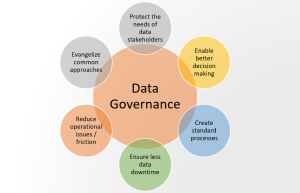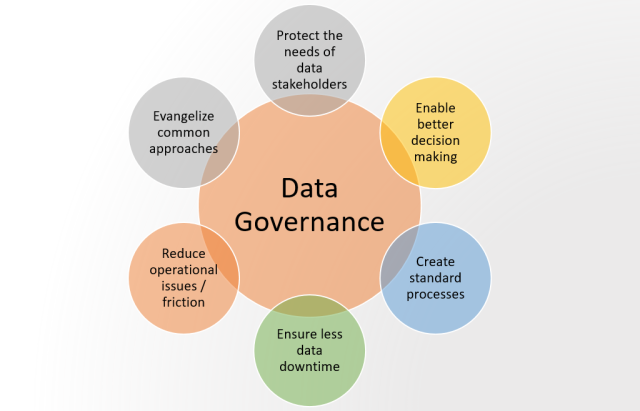
Data governance is an important element of any organization’s data management strategy. It provides a framework for creating, managing and monitoring data within an organization. This ensures that the data is accurate, consistent, secure, and compliant with all relevant regulations. It also allows organizations to make informed decisions based on quality data. In this blog post, we will explore the goals and objectives of good data governance and provide some examples to help you implement it in your organization.
Here is the picture representing the most important goals of data governance:
Protect the needs of data stakeholders
Data governance helps protect the needs of data stakeholders by ensuring that the data collected and used is compliant with any applicable regulations or industry standards. It also ensures that the data collected and stored is of a very high quality, with accurate and reliable information. Data governance helps to ensure that the data collected from internal and external data sources is managed properly, with appropriate security measures in place to protect it from unauthorized access or misuse. In other words, data governance helps avoid thee data leakage. It also helps to ensure that the data is handled in a manner that respects privacy concerns, such as preventing or minimizing sharing of personal information without explicit consent from the user or customer.
Data governance serves as a means for organizations to evaluate and understand their data usage practices from a risk perspective. This helps them prioritize activities within their organization when it comes to managing their data, such as regularly auditing security measures, updating back-ups, and investigating any potential issues that may come up regarding data misuse or unethically acquired information. This form of governance ensures that decisions made related to the management of data are based on sound principles, adhering to ethical standards and protecting the rights of those who are affected by its use.
Create standard data management & governance processes
One of the primary goal of any data governance practice is to create standard data management and governance processes that ensure data quality, security, accuracy and compliance with applicable laws or regulations. The ultimate purpose of a well-defined data governance strategy is to make sure that organizational objectives are met through the use of reliable, high quality data.
A comprehensive data governance plan ensures that all stakeholders (internal and external) have clear roles and responsibilities related to how their data is managed from its inception to its disposal. As part of this process, it’s important to document the different tasks associated with managing the lifecycle of data within the organization. This includes creating policies for data collection, storage, transformation, access control and disposal as well as setting up processes for regularly reviewing these practices.
One of the key aspect of setting up data governance processes is to set up system which could be used monitoring data usage patterns and conducting audits on an ongoing basis. This will help in identifying non-compliance issues or any unauthorized access or misuse of their valuable data assets. One other process can be to regularly run the tests against established standards for assessing data quality and the quality of the data sources.
Ensure less data downtime
One of the key data governance goals is to ensure that there is less data downtime. By reducing the amount of time where access to data is restricted or unavailable, organizations can ensure that their operations are running more efficiently and effectively. Data downtime hurts the end users most who are accessing data & insights via dashboard. Data downtime can be caused by anything from technical malfunctions to human errors, but no matter the cause, it can have significant impacts on an organization’s ability to make informed decisions and remain competitive.
In order to minimize data downtime, data governance strategy should encompass all areas of the business including the collection, storage, analysis and sharing of data. All stakeholders in the process should be included in this process and any changes need to be communicated clearly and promptly across all departments. Organizations should as well look into investing in new technologies such as machine learning algorithms to help reduce data downtime.
Reduce operational issues / frictions
At its core, data governance helps organizations reduce operational issues by creating a single source of truth for all organizational data. This means that data sources can be integrated across the organization and accessed through well-defined processes. Additionally, putting in place controls to ensure data security, reliability and accuracy reduces friction between departments or business units.
Data governance can create guidelines to help the organization find the right balance between collecting the right amount of data while maintaining privacy and security best practices. For example, organizations can determine when it’s necessary to store customer information such as name or email address versus when it should remain anonymous (i.e., using numerical identifiers instead). Moreover, strict access controls are applied to ensure only authorized personnel can access sensitive information.
Data governance can help reduces operational issues and friction by helping organization create consistent definitions for key terms used across different departments or systems. This ensures everyone within the organization understands what each term refers to and that decisions are made based on accurate information from reliable sources.
Evangelize the common approaches to managing data & resolving issues
Data governance is a key component of successful data management and its goal is to evangelize common approaches to managing data and resolving issues. This goal involves the proactive identification of areas in which organizations can improve their data management techniques, as well as implementing strategies that will allow individuals to access and use data more effectively.
One way to evangelize these commonly accepted approaches is by encouraging greater engagement with stakeholders across the organization. This could involve regular meetings with senior management, IT staff, and other data-related specialists, in order to discuss trends and best practices for managing data. It is also important that stakeholders have a clear understanding of the value of their data, so they can make informed decisions about how it should be managed. In addition, it is important that any changes or new policies related to data governance are communicated clearly across the organization in order to ensure everyone understands their role in maintaining a successful system.
Another way to evangelize common approaches for managing data is through education initiatives. These initiatives should involve providing training on topics such as: different types of data formats; tools available for capturing, organizing, analyzing, and sharing information; different legal and regulatory requirements related to collecting and using customer or employee-related information; security protocols for protecting sensitive information; etc.
Enable better decision making
Data governance enables better decision-making, as it allows organizations to assess the quality of their data, and ensure that decisions are being made based on accurate, timely and reliable information. This creates a more efficient and effective decision-making process that enhances organizational performance.
Data governance is centered around developing policies, practices and procedures to ensure the quality of data being used for decision making. This includes establishing rules for how data should be collected and stored, how it should be accessed, who has access to it, and what types of decisions can be made using the data. Data governance ensures that all stakeholders understand their responsibilities related to managing data so that everyone involved in the decision making process is aware of the guidelines they need to follow when working with the organization’s data.
Conclusion
The primary goals & objectives of good data governance is to not only ensures that customer or employee information remains secure but also enables an organization’s ability to capitalize on its own datasets by leveraging analytics capabilities such as descriptive analytics or predictive analytics in order to competitive advantage over its competitors. Data governance framework ensures the protection of need of the business stakeholders in terms of data leakage, data security, etc. When implemented correctly with clearly defined goals and objectives in mind, it can help any company stay one step ahead of its competitors while maximizing profitability potential at the same time! With this knowledge in hand, you are now ready to start developing a comprehensive plan for your organization’s own successful journey towards exemplary data governance!
- Coefficient of Variation in Regression Modelling: Example - November 9, 2025
- Chunking Strategies for RAG with Examples - November 2, 2025
- RAG Pipeline: 6 Steps for Creating Naive RAG App - November 1, 2025

I found it very helpful. However the differences are not too understandable for me